5. Muscule 1
1/58
There's no tags or description
Looks like no tags are added yet.
Name | Mastery | Learn | Test | Matching | Spaced |
|---|
No study sessions yet.
59 Terms
What percentage of body weight do muscles account for?
Muscles account for approximately 40% of body weight
What are three types of muscular tissue?
Skeletal, cardiac and smooth
How does muscle metabolism contribute to body temperature regulation?
The metabolism that occurs in muscle tissue produces heat, which is essential for maintaining body temperature. This heat production helps the body stay warm and is crucial for regulating internal temperature, especially during physical activity.
Which two characteristics catagories muscule tissue?
Whether control is voluntary or involuntary
Presence or absence of light or dark stripes
(striations/myofibrils*) in muscle cells
What does it mean for a muscle to be striated? In which type of muscle would you find striated and non-striated fibers?
A striated muscle has stripes extending transversely across its cells, which are visible under a microscope due to the arrangement of myofibrils. Striated fibers are found in cardiac and skeletal muscle and non-striated fibers are found in smooth muscle.
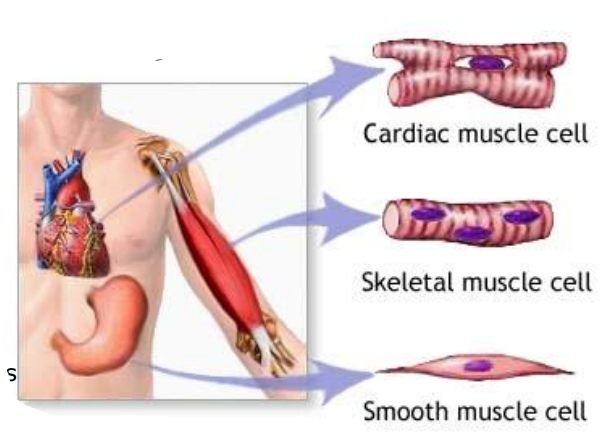
What is the difference between voluntary and involuntary muscle control?
Voluntary muscle control is conscious and can be controlled at will, while involuntary muscle control occurs automatically and is not under conscious control.
What are the functions of muscular tissue?
The functions of muscular tissue include producing body movement, stabilizing body position, storing and moving substances within the body, and producing heat.
In what ways do muscles contribute to stabilizing body position?
Muscles contribute to stabilizing body position through continuous contraction and muscle tone, which maintain an upright posture (feedback loop), and by providing stability through muscles and tendons that cross over joints.
How do muscles help in storing and moving substances within the body?
Muscles assist in storing and moving substances by facilitating the cardiovascular system's function, allowing sphincters (ringmuskel) to provide temporary storage, and moving contents through the digestive tract via contractions.
How do normal muscle contractions contribute to maintaining body temperature?
Normal muscle contractions generate heat, which helps maintain body temperature; this process is essential for metabolic functions and overall physiological balance.
What effect does shivering have on body temperature?
Shivering involves rapid, can be involuntary muscle contractions that increase heat production, thereby raising body temperature in response to cold environments.
What are the special functional characteristics that distinguish muscle tissue from other tissues?
The special functional characteristics that distinguish muscle tissue from other tissues include electrical excitability, contractility, extensibility, and elasticity.
What does electrical excitability refer to in muscle tissue?
Electrical excitability refers to the ability of muscle tissue to respond to stimuli (electrical or chemical) by producing an electrical signal known as an action potential.
What is contractility, and how does it affect muscle function?
Contractility is the ability of muscle tissue to contract forcefully when stimulated. This property allows muscles to shorten and generate tension, enabling movement.
How much can a muscle contract to its resting length when stimulated?
When stimulated, a muscle can contract to about 70% of its resting length.
What does extensibility mean in the context of muscle tissue?
Extensibility refers to the ability of muscle tissue to be stretched within certain limits without being damaged.
How does elasticity relate to muscle tissue?
Elasticity is the property of muscle tissue that allows it to return to its original length and shape after being contracted or extended, helping maintain its functional integrity.
What are the main locations of skeletal muscle tissue in the body?
Skeletal muscle tissue is located in skeletal muscles and is attached to the skeleton or skin by tendons.
What type of control does skeletal muscle tissue have, and how does this affect its contraction speed?
Skeletal muscle tissue is under voluntary control, allowing for fast contractions; however, it does not exhibit rhythmicity.
What are myofibrils, and what role do they play in the structure and function of striated muscle tissue?
Myofibrils are long, rod-shaped structures found within striated muscle cells (skeletal and cardiac muscle). They are composed of repeating units called sarcomeres
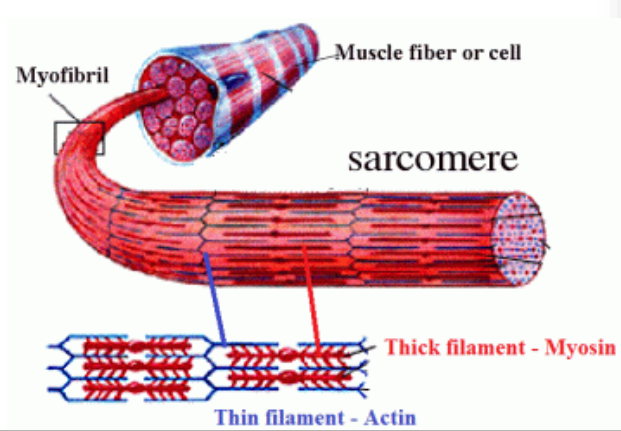
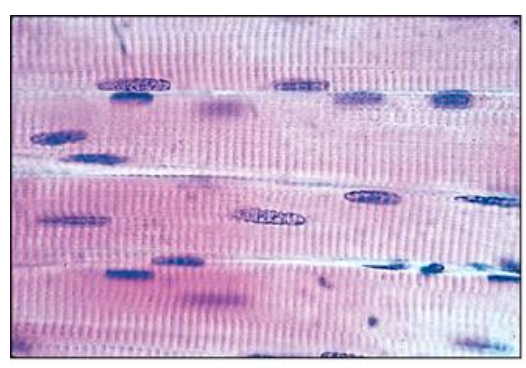
Define the different parts of skeletal muscule tissue
Connective tissue
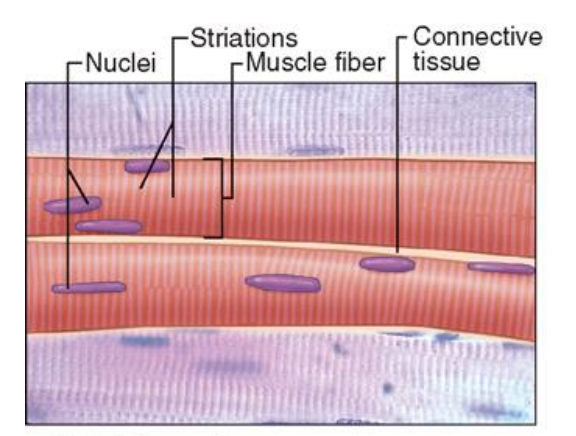
Where is cardiac muscle tissue primarily found?
Cardiac muscle tissue is primarily found in the heart wall and forms the majority of heart tissue (cardiocytes).
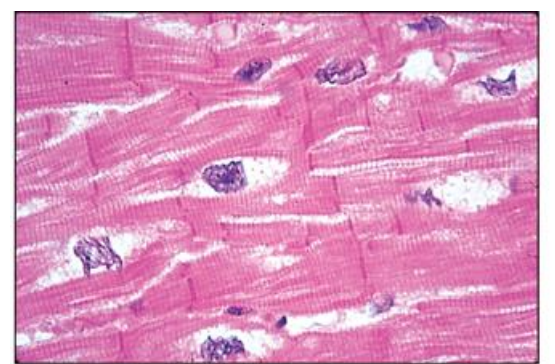
What are cardiac muscle tissue unique histological features?
It is striated, with myofibrils organized into sarcomeres, and features intercalated discs that connect individual heart muscle cells.
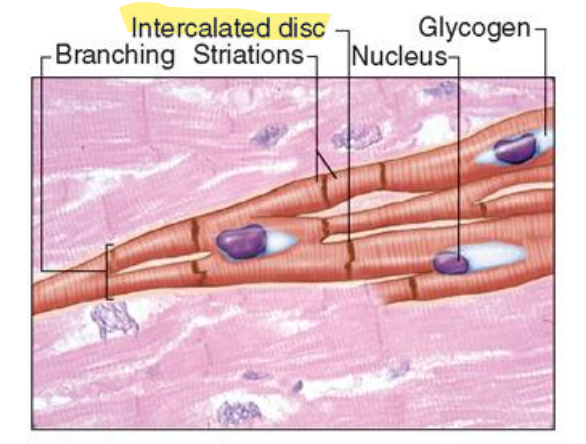
What type of control does cardiac muscle tissue have, and how does this impact its contraction?
Cardiac muscle tissue is involuntary and cannot contract without neural stimulation. It has a moderate contraction speed and exhibits auto-rhythmicity due to pacemaker cells that generate action potentials spontaneously. The pace and amount of tension can be adjusted by nervous system
How does the contraction duration of cardiac muscle compare to that of skeletal muscle?
The contractions of cardiac muscle are approximately 10X longer than those of skeletal muscle.
What is the primary function of smooth muscle tissue, and where is it typically located?
Smooth muscle tissue is located in the walls of hollow internal structures, such as blood vessels and the gastrointestinal tract, and it regulates blood flow and the movement of materials within these organs.
How is smooth muscle tissue organized, and what are its contraction characteristics?
Smooth muscle tissue is usually organized into two layers: circular and longitudinal. It is non-striated, involuntary, and characterized by slow, prolonged contractions.
Does smooth muscle tissue have auto-rhythmicity and if so where can it be observed?
Yes, some have auto-rhythmicity, this can be observed in the walls of the gastrointestinal tract.
What are erector pili muscles, and how are they related to smooth muscle tissue?
Erector pili muscles are small smooth muscles located at the base of hair follicles. When these muscles contract, usually in response to cold temperatures or emotional stimuli, they cause the hair to stand upright, a phenomenon known as piloerection
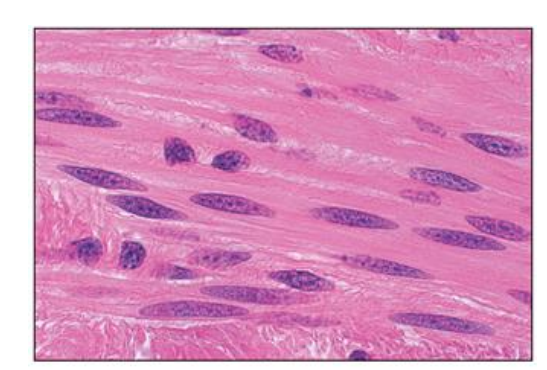
Define the different parts of smooth muscule tissue
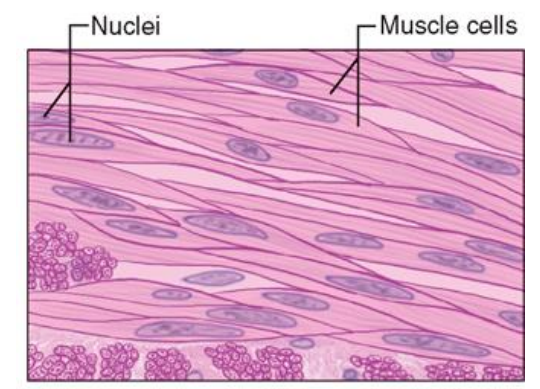
What is the most abundant (highest quantity) tissue in the vertebrate body?
Skeletal muscle is the most abundant tissue in the vertebrate body.
How do skeletal muscles produce movement at joints? What are the fixed and moving ends of a skeletal muscle called?
Skeletal muscles cross over a joint and pull on the distal bone to produce movement. The fixed end is called the origin, and the moving end is called the insertion.

Why is it important that skeletal muscles are strongly vascularized?
Strong vascularization is important for skeletal muscles because it ensures an adequate supply of oxygen and nutrients, which are necessary for muscle function and endurance.
What does it mean for skeletal muscles to be well innervated?
Being well innervated means that skeletal muscles have a rich supply of nerves, allowing for precise control of muscle contractions and coordination of movement.
Is the whole skeletal muscule considered to be organ and what tissues does it consists of?
A whole skeletal muscle is considered an organ of the muscular system and consists of skeletal muscle tissue, connective tissue, nerve tissue, and blood (vascular) tissue.
What factors contribute to the variation in skeletal muscle size, shape, and fiber arrangement?
Skeletal muscles vary considerably in size, shape, and fiber arrangement due to their specific functions and locations in the body. They can range from tiny muscles like the stapedium in the middle ear to large muscles like those in the thigh. Some skeletal muscule are broad in shape and some narrow. Muscle fibers in skeletal muscles can be arranged in various ways, including parallel to the long axis of the muscle, converging to a narrow attachment, or oblique to the axis of the muscle.
What is the typical structure of a skeletal muscle?
The typical structure of a skeletal muscle consists of a muscle belly connected by tendons to the skeleton. The shape of the belly and the tendons can vary depending on the specific muscle and its function.
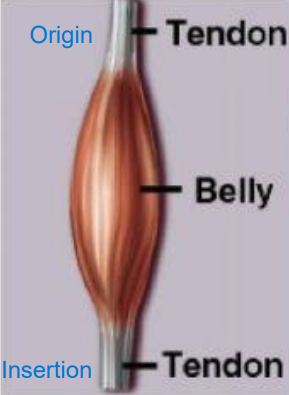
What is skeletal muscule fiber?
A skeletal muscle fiber is a long, cylindrical cell that makes up skeletal muscle tissue. These fibers are characterized by their relatively large diameter, which can be up to 100 µm, making them about ten times larger than an average body cell.
Skeletal muscle fibers run the entire length of a muscle, varying in size from several centimeters in shorter muscles to up to 30 centimeters in longer muscles.
How are skeletal muscle fiber formed?
Each skeletal muscle fiber is formed through the fusion of hundreds of embryonic cells called myoblasts, resulting in a multinucleated structure.
When are most skeletal muscle fibers formed, and how does this affect their quantity in adulthood?
Most skeletal muscle fibers are formed before birth, so the number of fibers does not significantly change in adulthood.
What stimulates the growth in size (hypertrophy) of skeletal muscle fibers?
Growth in size (hypertrophy) of skeletal muscle fibers is stimulated by growth and sexual hormones during teen years.
How does skeletal muscle tissue compare in terms of regeneration?
Skeletal muscle tissue has poor regeneration capabilities, which means that it does not heal or regenerate well after injury compared to other types of tissue.
What are the three layers of connective tissue associated with skeletal muscle, and how are they connected?
The three layers of connective tissue associated with skeletal muscle are the epimysium, perimysium, and endomysium, and they are continuous with each other.
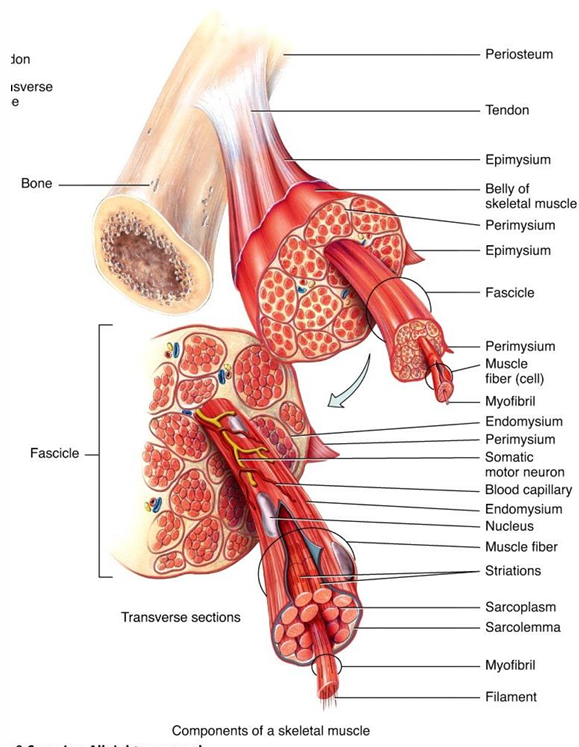
What is the function of the epimysium in skeletal muscle?
The epimysium surrounds the entire muscle and acts as a most outer coat made of dense, irregular connective tissue, providing structural support and protection. Sometimes blends with deep facia that lies between neighbouring muscles
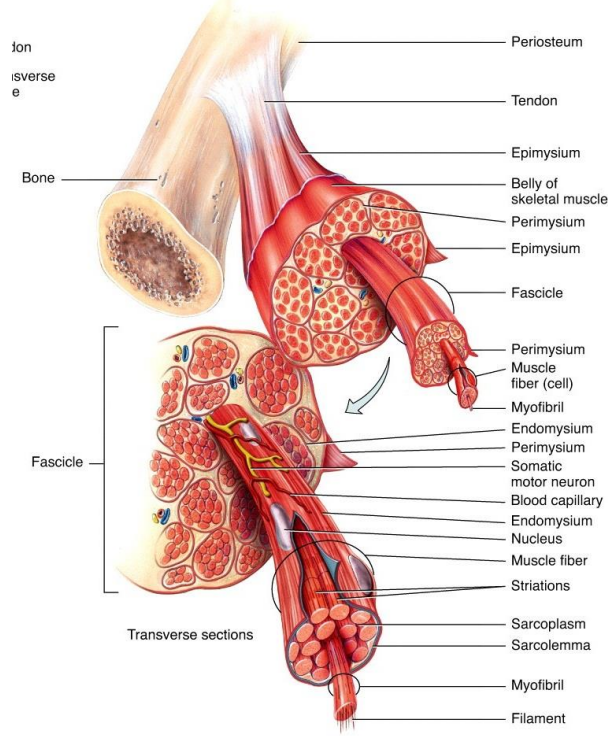
What is the role of the perimysium within a skeletal muscle?
The perimysium divides muscle fibers into groups known as fascicles, resembling bundles of sticks, and surrounds these fascicles with a layer of fibrous connective tissue. It organises these fibers and provide stability and support

How does the endomysium contribute to the organization of skeletal muscle fibers?
The endomysium surrounds each individual muscle fiber within a fascicle, providing a fine sheath of loose connective tissue that helps support and protect the fibers while allowing for flexibility and movement.

How do skeletal muscles extend from one bone to another, and what is the significance of this arrangement?
Each skeletal muscle extends from one bone to another, crossing at least one movable joint (and sometimes two). This arrangement allows for movement at the joint when the muscle contracts, with one bone being moved while the other remains fixed.
In the context of skeletal muscle attachments, what is the difference between the origin and insertion? How does that apply to limbs?
The origin of a muscle is the less movable attachment point, while the insertion is the more movable attachment point. Upon contraction, the insertion is pulled toward the origin. In the limbs, the origin is usually the more proximal attachment (closer to the center of the body), while the insertion is more distal (farther from the center of the body). For example, in the brachialis muscle, the origin is the humerus and the insertion is the ulna in a typical limb position, but during chin-ups, the humerus moves while the ulna remains fixed.
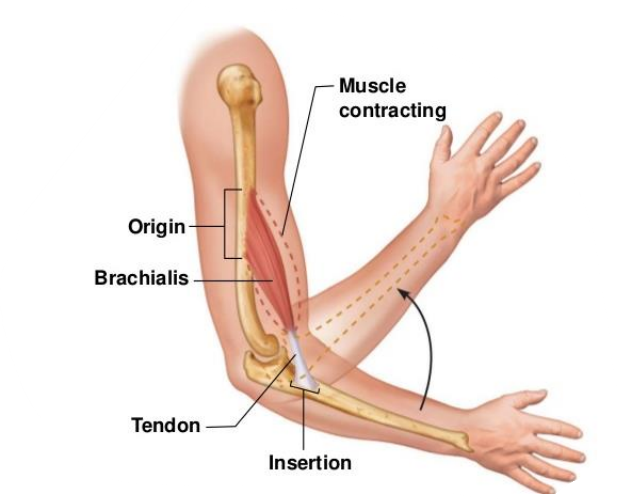
What type of connective tissue is involved in attaching muscles to bones, and how does it connect to the bone?
Skeletal muscles attach to bones through strong fibrous connective tissue that extends into the periosteum of the bone, anchoring the muscle securely.
What is the difference between direct and indirect attachment of muscles to bones?
Direct attachment occurs when the attaching strands of connective tissue are so short that the muscle appears to be directly connected to the bone. In contrast, indirect attachment, which is more common, involves connective tissue that extends well beyond the ends of the muscle fibers, forming tendons or aponeuroses.
In what ways do tendons differ from aponeuroses regarding their structure and function?
Tendons are typically cylindrical and cord-like, connecting muscles to bones, while aponeuroses are flattened and sheet-like, allowing for broad attachments to bone or fascia. Both structures are composed of the same layers of connective tissue but serve different functional roles based on their shape.
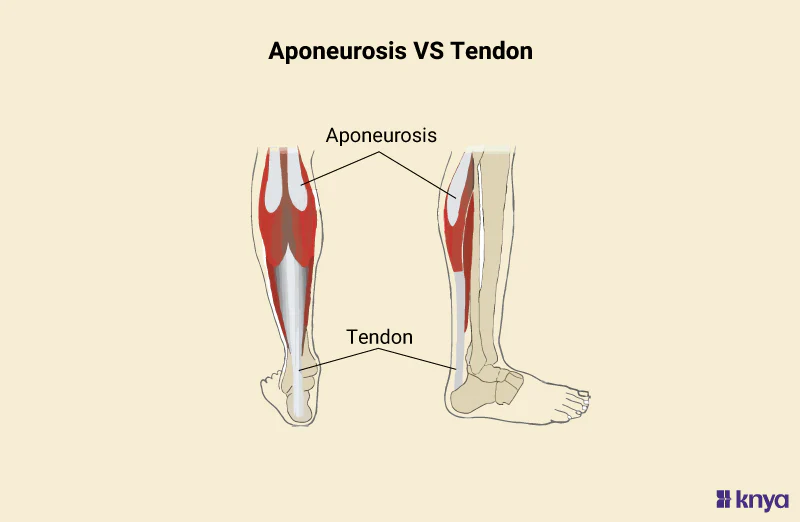
What are raised bone markings, and how do they relate to tendons?
Raised bone markings, such as tubercles, trochanters, and crests, are bony projections that serve as attachment points for tendons.
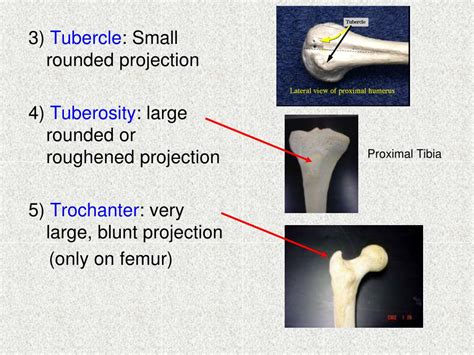
How many main nerves does each muscle receive for motor and sensory innervation?
Each muscle receives one main nerve that carries both motor and sensory innervation.
Where does the nerve supply enter the muscle, and what structure accompanies it?
The nerve supply enters the muscle at the extremity close to the origin, accompanying the blood vessels in what is referred to as a neurovascular bundle.
At what point do individual nerve fibers reach individual muscle fibers, and what is this connection called?
Individual nerve fibers reach individual muscle fibers at mid-length, and this connection is called the neuromuscular junction or synapse.
What does a rich blood supply to muscles indicate about their functional demands?
A rich blood supply reflects the high demand that contracting muscles have for oxygen (O2) and nutrients, which are necessary for energy production during muscle activity.
How many arteries and veins typically supply each muscle?
Each muscle is typically supplied by one artery and one or two veins.
How do blood vessels branch within the muscle?
Blood vessels branch repeatedly within the intramuscular tissue, ensuring that the blood supply reaches individual muscle fibers.
What is the relationship between muscle fibers and capillaries?
Muscle fibers are surrounded by networks of capillaries, which provide the necessary oxygen and nutrients for muscle function and remove waste products.